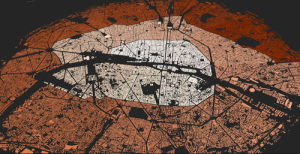The fall semester begins next week at UC Berkeley. For the third year in a row, Paul Waddell and I will be teaching CP255: Urban Informatics and Visualization, and this is my first year as co-lead instructor.
This masters-level course trains students to analyze urban data, develop indicators, conduct spatial analyses, create data visualizations, and build  interactive web maps. To do this, we use the Python programming language, open source analysis and visualization tools, and public data.
interactive web maps. To do this, we use the Python programming language, open source analysis and visualization tools, and public data.
This course is designed to provide future city planners with a toolkit of technical skills for quantitative problem solving. We don’t require any prior programming experience – we teach this from the ground up – but we do expect prior knowledge of basic statistics and GIS.
Update, September 2017: I am no longer a Berkeley GSI, but Paul’s class is ongoing. Check out his fantastic teaching materials in his GitHub repo. From my experiences here, I have developed a course series on urban data science with Python and Jupyter, available in this GitHub repo.
Teaching agenda for this semester:
Learning basic Python coding: we spend about 3 weeks introducing the fundamentals of coding, data types, conditionals, loops, and functions. Just enough to make you dangerous.
The scientific computing Python stack, via Anaconda: we introduce numpy, scipy, statsmodels, pandas for data analysis, and matplotlib for visualization.
CartoDB for simple interactive web mapping.
Leaflet and MapBox: more advanced web mapping for community engagement, advocacy, and visualizing research findings.
Installing, customizing, and using WordPress: each student creates a customized blog as a web portfolio to share and publicize their projects from class.
GitHub for version control and collaborative development.
QGIS: a powerful, free, and open-source alternative to ArcGIS.
Data wrangling, regression, spatial statistics, and spatial analysis with Python and the pandas and geopandas libraries.
Machine learning: including feature engineering and selection, dimensionality reduction, modeling, and clustering in Python with scipy and scikit-learn.
Modeling and visualizing urban accessibility, walkability, street networks and the built form.
Working with APIs, including the census bureau, Socrata (via the City of Berkeley’s open data portal), Google’s geocoding services, and the Twitter API (including mapping and visualizing tweets).
Critical thinking skills about urban data and big data: how to formulate research questions, conceptualize possible solutions, and interrogate problems with equity and representation.
Our guest speakers this semester include Alicia Rouault and Prashant Singh – the CEO and CTO, respectively, of LocalData; Michal Migurski, the CTO of Code for America; Eddie Tejeda, the CEO of Civic Insight; Donna LaSala, the Director of Information Technology for the City of Berkeley; AutoDesk’s Matt Davis; and my fellow doctoral student, Sam Maurer.
10 replies on “Urban Informatics and Visualization at UC Berkeley”
[…] See more about this article by clicking the link here: http://geoffboeing.com/2015/08/urban-informatics-visualization-berkeley/ […]
If you need any case studies let me know…the City of Miami would love to offer ourselves to expand our data capabilities.
Thanks Dave! We need to chat some time soon and put our heads together. There might be a cool opportunity here.
Hey,
How do we sign up for this course? Is it possible if I’m not a Berkley student?
This class is only offered to registered UC Berkeley students. But our lectures and materials are available freely online at the GitHub repo I linked above. Feel free to follow along!
I bet that your students will have some facebook group, or g+, etc.
Is is possible to connect with them? I’m not Berkeley student but I would love to participate in this course and so far it’s impossible. If I could just join some group where they discuss things from this course it would be wonderful.
[…] Course materials, IPython notebooks, & tutorials from CP255: Urban Informatics and Visualization at UC Berkeley. For more on the course see http://geoffboeing.com/2015/08/urban-informatics-visualization-berkeley/ […]
[…] Urban Informatics and Visualization at UC Berkeley […]
[…] and basemap. I made the interactive map with Leaflet. For more on these methods, check out our Urban Informatics and Visualization course at UC Berkeley or see my GitHub repo for the […]
[…] Python scientific stack is now all ready to use on the Raspberry Pi. Launch a Jupyter notebook, load up some data with pandas, or plot a map with basemap. Due to the Raspberry Pi’s memory […]